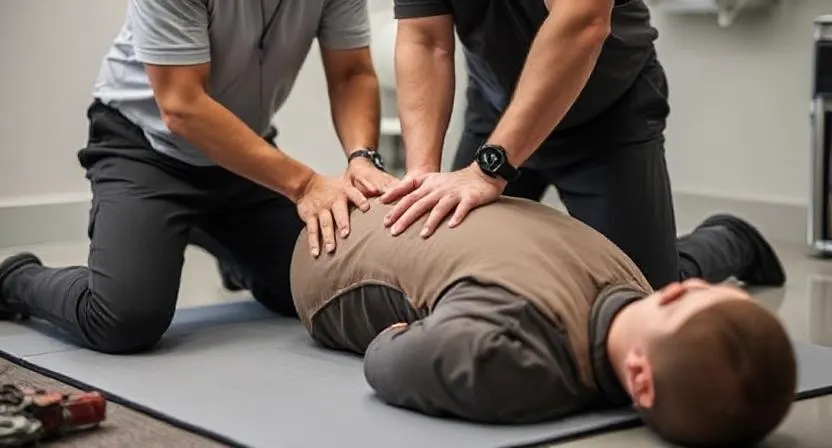During High Quality CPR When Do Rescuers Typically Pause Compressions is an essential life-saving method that greatly increases a person going into cardiac arrest’s chances of survival. Effective chest compressions are one of the most crucial components of high-quality CPR. But during high quality cpr when do rescuers typically pause compressions. This question is essential to understand in order to ensure CPR is done correctly and efficiently.
What is During High Quality CPR When Do Rescuers Typically Pause Compressions?
High-quality CPR involves providing the best possible chest compressions and rescue breaths to someone who is experiencing cardiac arrest. The key elements of high-quality CPR include:
- Compression depth: At least 2 inches deep for adults
- Compression rate: 100 to 120 compressions per minute
- Allowing full chest recoil: Letting the chest return to its normal position between compressions
- Minimal interruptions: Keeping pauses to an absolute minimum
However, during high quality cpr when do rescuers typically pause compressions? Understanding this is crucial because these pauses can affect the effectiveness of CPR.
When to Pause Compressions for Rescue Breaths
Rescuers usually only pause compressions for a few seconds to administer rescue breaths in high-quality CPR. In order to give two efficient rescue breaths, chest compressions must be stopped for a brief period of time after being administered at the correct depth and pace. To reduce the disruption of the chest compressions, this interval is usually short, lasting only one second every breath. During high quality cpr when do rescuers typically pause compressions? Only when giving rescue breaths, to allow air to enter the victim’s lungs.
When to Pause for Defibrillation
Another situation when during high quality cpr when do rescuers typically pause compressions is when preparing to use an Automated External Defibrillator (AED). To ensure reliable results, the AED needs to pause compressions for a short period of time while it examines the victim’s cardiac rhythm. Chest compressions should start right away after the shock is administered. Usually, this gap lasts just five seconds so the AED can assess the situation and perhaps shock the user.
The Importance of Minimizing Pauses in Compressions
While certain situations require brief pauses in compressions, it’s critical that these pauses are kept as short as possible.during high quality cpr when do rescuers typically pause compressions Only for rescue breaths or during defibrillation analysis. Any unnecessary interruptions in chest compressions can significantly decrease the effectiveness of CPR and reduce the chances of survival for the victim. Studies show that minimizing pauses during CPR leads to better outcomes.
Performing During High Quality CPR When Do Rescuers Typically Pause Compressions with Minimal Pauses
To perform high-quality CPR, rescuers should strive to minimize the duration of pauses between compressions. Even during rescue breaths and defibrillation analysis, rescuers should aim to keep pauses as brief as possible. during high quality cpr when do rescuers typically pause compressions. Only for these essential moments, but they must act quickly and efficiently to resume compressions as soon as possible.
How Long Should the Pauses Be?
It’s crucial to comprehend how long pauses last during effective CPR. For instance, when do rescuers usually pause compressions for rescue breaths during high-quality CPR? One second each breath, or just long enough to produce two breaths, should be the duration of the pause. Similarly, you should pause for approximately five seconds during the analysis phase while utilizing an AED. Minimizing pauses improves the victim’s chances of survival by preserving blood flow to critical organs including the brain.
The Role of a Team During High-Quality CPR
One member of the team may be responsible for chest compressions while another concentrates on administering rescue breaths or utilizing the AED when performing high-quality CPR. Rescue breath and defibrillation pauses are still required in these situations, but the team makes an effort to shorten their duration. During high quality cpr when do rescuers typically pause compressions It’s during these team efforts, where each member focuses on a specific task to ensure continuous chest compressions.
Challenges in Pausing Compressions
Maintaining excellent CPR with few pauses might be challenging in various circumstances. Longer pauses may occur, for example, if the rescuer is by themselves and must switch between rescue breaths and chest compressions. But during high quality cpr when do rescuers typically pause compressions. It’s still only for the critical moments, such as during rescue breaths or defibrillation analysis. Training and practice help reduce these challenges, enabling rescuers to act swiftly and confidently.
Why Pauses Matter in During High Quality CPR When Do Rescuers Typically Pause Compressions
It’s important to understand why pauses during high-quality CPR matter. When chest compressions are paused for too long, the victim’s heart stops receiving the necessary blood flow, decreasing their chances of survival. Studies show that minimizing these pauses as much as possible increases the effectiveness of CPR. So, during high quality cpr when do rescuers typically pause compressions. Only when it’s absolutely necessary for rescue breaths or defibrillation.
Training for Effective High-Quality CPR
To guarantee that rescuers understand when to pause compressions and how to carry out each step appropriately, high-quality CPR training is essential. People who take CPR training learn how to use an AED correctly, do rescue breaths, and perform successful chest compressions. The most important lesson is to avoid taking too long breaks and to always make sure that chest compressions are started as soon as possible following any required breaks.
Conclusion
During high quality cpr when do rescuers typically pause compressions. The answer is straightforward: only when using an AED or giving rescue breaths. To maintain constant blood flow to key organs, pauses should be as short as feasible, even if they are required for these crucial functions. The victim’s survival and the effectiveness of CPR depend on the chest compressions being performed with the fewest possible interruptions. The sufferer has the highest chance of surviving when rescuers are trained and practiced to execute high-quality CPR with little pauses.

















Leave a comment